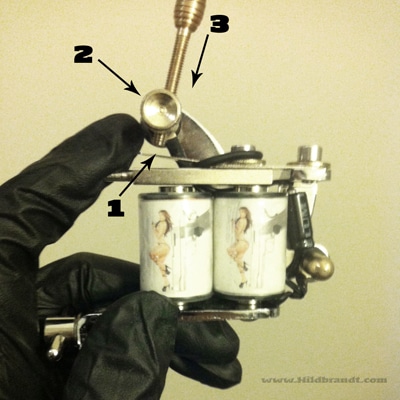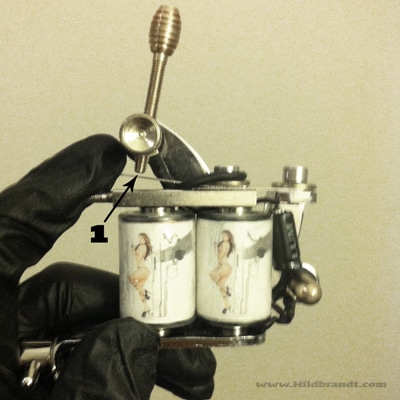Okay we realize for the non-newbies out there the question of how to tune a tattoo machine to work is pretty stupid. This post is for the super noob, the ones that we and every other tattoo supply company gets a phone call from every day, several times a day. The only difference with us is that we are one of the only supply companies in this part of the western hemisphere that will bother to explain to a rookie how to tune their tattoo machine to work.
So heres the scenario: You get your brand new tattoo machine in the mail, anxiously rip open the package, hook it up to your power supply, press the foot pedal and…. nothing, not even a whimper. Must be the builders fault right? Wrong. That piece of equipment you are holding is like an electric guitar, tune it right and it’ll make music. Tune it wrong and it will do nothing. Take a look at the picture below.

Arrow 1 points to the armature bar, arrow 2 points to the contact screw, 3 points to the front spring (the angled piece of metal that shoots up from the armature bar) and arrow 4 points to the thumbscrew that tightens the contact screw. Some machines may not have this thumbscrew and may instead have a locking nut that is found on the contact screw itself, they serve the same purpose, to lock the contact screw in place. These 4 parts are pointed out because these are the 4 main parts involved with tuning the machine to work.

Now remember, this tutorial is only to teach you how to get your machine to run, I never said anything about teaching you about how to fine tune it to be the perfect shader, liner or color packer, that I’ll leave up to you or your mentor whom I hope you are getting an apprenticeship from before you consider giving anyone a tattoo. So with that said, first thing we need to do is to find the gap between the front spring and the contact screw tip (end where the contact screw touches the front spring). Holding your machine with your left hand, use your pointer finger to hold down the armature bar to the top of the coils, this will generate a gap between the front spring and the contact screw tip. If that gap is anything over the width of 2 nickels stacked together, its probably not going to do anything when you power it up. The general rule of thumb for starting position is dime gap for liner and nickel gap for shader. This means that the gap of the front spring to the contact screw point (while you are holding down the armature bar to create the gap) should be the width of a nickel for shading and the width of the dime for lining. Arrow 2 points to the thumbscrew that locks the contact screw, loosen this to release the contact screw. Arrow 3 points to the contact screw, screw it downward towards the front spring to the appropriate gap width for shader or liner. When you are done, tighten the thumbscrew again to lock the contact screw in place and let go of the armature bar. Run the machine at 10V (a little high for normal usage but a good jolt for troubleshooting). It’s alive!

Now we are all set, see the gap arrow 1 is pointing to? That is a dime width, this machine is set to work as a liner. The dime gap liner and nickel gap shader is an old school method of tuning. It is also one of the most basic. As one progresses, he/she will undoubtedly find variations on how to fine tune their machine for lining, shading, color packing, etc.. These variations take into account the thickness of the springs you got on, what wrap the coils are, what uf the capacitor is, etc.. So this is by no means an exhaustive tutorial on tuning, but it does give you newbies a starting point.